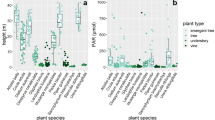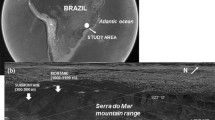Summary
Foliar 13C-abundance (δ13C) was analyzed in the dominant trees of a temperate deciduous forest in east Tennessee (Walker Branch Watershed) to investigate the variation in foliar δ13C as a function of time (within-year and between years), space (canopy height, watershed topography and habitat) and species (deciduous and coniferous taxa). Various hypotheses were tested by analyzing (i) samples collected from the field during the growing season and (ii) foliar tissues maintained in an archived collection. The δ13C-value for leaves from the tops of trees was 2 to 3%. more positive than for leaves sampled at lower heights in the canopy. Quercus prinus leaves sampled just prior to autumn leaf fall had significantly more negative δ13C-values than those sampled during midsummer. On the more xeric ridges, needles of Pinus spp. had more positive δ13C-values than leaves from deciduous species. Foliar δ13C-values differed significantly as a function of topography. Deciduous leaves from xeric sites (ridges and slopes) had more positive δ13C-values than those from mesic (riparian and cove) environments. On the more xeric sites, foliar δ13C was significantly more positive in 1988 (a dry year) relative to that in 1989 (a year with above-normal precipitation). In contrast, leaf δ13C in trees from mesic valley bottoms did not differ significantly among years with disparate precipitation. Patterns in foliar δ13C indicated a higher ratio of net CO2 assimilation to transpiration (A/E) for trees in more xeric versus mesic habitats, and for trees in xeric habitats during years of drought versus years of normal precipitation. However, A/E (units of mmol CO2 fixed/mol H2O transpired) calculated on the basis of δ13C-values for leaves from the more xeric sites was higher in a wet year (6.6±1.2) versus a dry year (3.4±0.4). This difference was attributed to higher transpiration (and therefore lower A/E) in the year with lower relative humidity and higher average daily temperature. The calculated A/E values for the forest in 1988–89, based on δ13C, were within ±55% of estimates made over a 17 day period at this site in 1984 using micrometeorological methods.
Similar content being viewed by others
References
Baldocchi DD, Verma SB, Anderson DE (1987) Canopy photosynthesis and water-use efficiency in a deciduous forest. J Appl Ecol 24:251–260
Ehleringer JR, Field CB, Lin Z, Kuo C (1986) Leaf carbon isotope and mineral composition in subtropical plants along an irradiance cline. Oecologia 70:520–526
Ehleringer JR, Lin Z, Field CB, Sun GC, Kuo CY (1987) Leaf carbon isotope ratios of plants from a subtropical monsoon forest. Oecologia 72:109–114
Farquhar GD, Richards RA (1984) Isotopic composition of plant carbon correlates with water-use efficiency of wheat genotypes. Aust J Plant Physiol 11:539–552
Farquhar GD, Hubick KT, Condon AG, Richards RA (1989) Carbon isotope fractionation and plant water-use efficiency. In: Rundel PW, Ehleringer JR, Nagy KA (eds) Stable isotopes in ecological research. Springer Verlag, New York, pp 21–40
Farquhar GD, O'Leary MH, Berry JA (1982) On the relationship between carbon isotope discrimination and the intercellular carbon dioxide concentration in leaves. Aust J Plant Physiol 9:121–137
Field C, Merino J, Mooney HA (1983) Compromises between water-use efficiency and nitrogen-use efficiency in five species of California evergreens. Oecologia 60:384–389
Francey RJ, Gifford RM, Sharkey TD, Weir B (1985) Physiological influences of carbon isotope discrimination in huon pine (Lagarostrobos franklinii). Oecologia 66:211–218
Garrett HE, Cox GS, Roberts JE (1978) Spatial and temporal variations in carbon dioxide concentrations in an Oak-Hickory forest ravine. Forest Science 24:180–190
Hutchison BA, Matt DR, McMillen RT, Gross LJ, Tajchman SJ, Norman JM (1986) The architecture of an East Tennessee deciduous forest canopy. J Ecol 74:635–676
Johnson DW, Van Hook RI (eds) (1989) Analysis of biogeochemical cycling processes in Walker Branch watershed. Springer-Verlag, New York
Medina E, Minchin P (1980) Stratification of δ13C-values of leaves in Amazonian rain forests. Oecologia 45:377–378
O'Leary MH (1988) Carbon isotopes in photosynthesis. Bio Science 38:328–336
Schleser GH (1980) Investigations of the δ13C pattern in leaves of Fagus sylvatica L. J. Exp Botany 41:565–572
Schleser GH, Jayasekera R (1985) δ13C-variations of leaves in forests as an indication of reassimilated CO2 from the soil. Oecologia 65:536–542
Sternberg LSL, Mulkey SS, Wright SJ (1989a) Ecological interpretation of leaf carbon isotope ratios: influence of respired carbon dioxide. Ecology 70:1317–1324
Sternberg LSL, Mulkey SS, Wright SJ (1989b) Oxygen isotope ratio stratification in a tropical moist forest. Oecologia 81:51–56
Timmins S, Chason J (1991) 1989 Walker Branch Watershed Surveying and Mapping Including A Guide to Coordinate Transformation Procedures, ORNL/TM-11571. Oak Ridge National Laboratory, Oak Ridge, Tennessee 37830
Winter K, Holtum JAM, Edwards GE, O'Leary MH (1982) Effect of low relative humidity on δ13C value in two C3 grasses and in Panicum milioides, a C3-C4 intermediate species. J Exp Bot 33:88–91
Author information
Authors and Affiliations
Rights and permissions
About this article
Cite this article
Garten, C.T., Taylor, G.E. Foliar δ13C within a temperate deciduous forest: spatial, temporal, and species sources of variation. Oecologia 90, 1–7 (1992). https://doi.org/10.1007/BF00317801
Received:
Accepted:
Issue Date:
DOI: https://doi.org/10.1007/BF00317801




